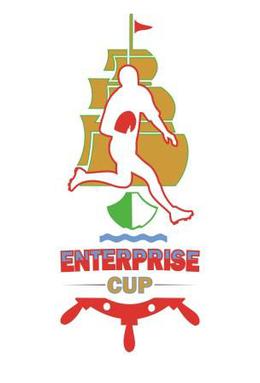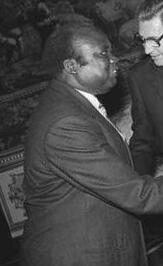
Idi Amin Dada Oumee was a Ugandan military officer and politician who served as the third president of Uganda from 1971 to 1979. He ruled as a military dictator and is considered one of the most brutal despots in modern world history.

The Uganda national rugby union team are a national sporting side of Uganda, representing them at rugby union. Rugby union was introduced by the British during colonial rule and Uganda played their first international game against Kenya in 1958. They have not yet qualified for the Rugby World Cup.

Rugby union in Kenya is a popular sport, in particular due to the success of the Kenya national rugby sevens team in the rugby sevens format, and tournaments such as the Safari Sevens, which has been growing yearly, and now includes numerous international teams.
Didier Camberabero, is a former French international rugby union player. He played as fly half.
Articles related to Uganda include:

The Elgon Cup is contested between the rugby union teams of Kenya and Uganda. The men's and women's teams of these countries each compete annually for their respective cups on a Home-and-Away basis. The competition and the cups are named after Mount Elgon, a mountain on the border of the two countries.
In 1955 the British Lions rugby union team toured Southern and Eastern Africa. The Lions drew the test series against South Africa, each team winning two of the four matches. They won the first test by a single point and the third by three points and lost the second and fourth matches by wider margins. As well as South Africa, the tour included a match against South West Africa, two games against Rhodesia and one versus East Africa.

Rugby union is a growing sport in the Cayman Islands. The Cayman Islands national rugby union team is ranked 62nd in the world, with 2,256 registered players.
Rugby union is a minor, but developing sport in Jordan.

Rugby union in Malawi, and its predecessor state, Nyasaland, is a minor sport, albeit one with a long history.
Rugby union in Norway is a minor but growing sport.
Rugby union in Mauritius is a minor but growing sport

Established in 1950, the East Africa rugby union team is a multi-national rugby union team drawing players from Kenya, Uganda and Tanzania, though the vast majority of these came from Kenya which has traditionally been the strongest rugby playing nation in the region. The team has played against incoming international, representative and club touring sides and it conducted seven tours between 1954 and 1982.

The Bamburi Super Series was an East African Rugby union competition with eight teams in total, five teams from Kenya two from Uganda and one from Tanzania (Twigas) that is currently defunct. It is closely based on the Super Rugby competition in the southern hemisphere. Games take place at the RFUEA Ground in Nairobi (Kenya), Friedkin Recreation Centre in Arusha (Tanzania) and the Kyadondo Grounds, Kampala (Uganda). Rhinos have won the most titles with four wins, and are the only team to have defended a title when they beat the Cheetahs 25–5 in the 2010 final.

The Enterprise Cup is an annual rugby union competition in Kenya, Tanzania and Uganda, though the competition frequently has the appearance of being an all-Kenyan affair as the majority of rugby clubs in the African Great Lakes region are based in this one country and frequently clubs in Tanzania and Uganda are unable to take part due to financial constraints. The original cup was donated by sailors from HMS Enterprise, who had toured British East Africa in 1928. The only years in which the competition has not been played is between 1940–1946 due to World War II and in 1987 because an international rugby competition was held on RFUEA Ground as part of the All Africa Games.
Rugby union in East Africa is almost entirely an amateur sport. It has been played in the three East African nations for more than a century; the first recorded match taking place in 1909, though it was almost certainly being played for several years prior to this. There are many club and school teams, the oldest of which were established in Colonial times.
Kyadondo Rugby Club is a rugby union ground in Kampala, Uganda.
The Battle of Jinja was a battle of the Uganda–Tanzania War that took place on 22 April 1979 near and in the city of Jinja, Uganda between Tanzanian and allied Uganda National Liberation Front forces, and Ugandan troops loyal to Idi Amin. The Tanzanians and the UNLF men met slight resistance and captured Owen Falls Dam and the town of Jinja.

Ernest Obitre Gama is a former lieutenant colonel in the Uganda People's Defence Force and was the first soldier in Uganda to be appointed minister when Idi Amin appointed him to become his first Minister of Internal Affairs. He later was an ambassador for Yoweri Museveni to Japan, Italy, and Sudan.
Abdul Abdallah Nasur was a Ugandan retired military officer and administrative official. Under President Idi Amin he served as Governor of Central Province from January 1975 to January 1976 and from August 1976 to April 1979, when Amin was overthrown. He also served as Governor of Karamoja Province from January to August 1976.









